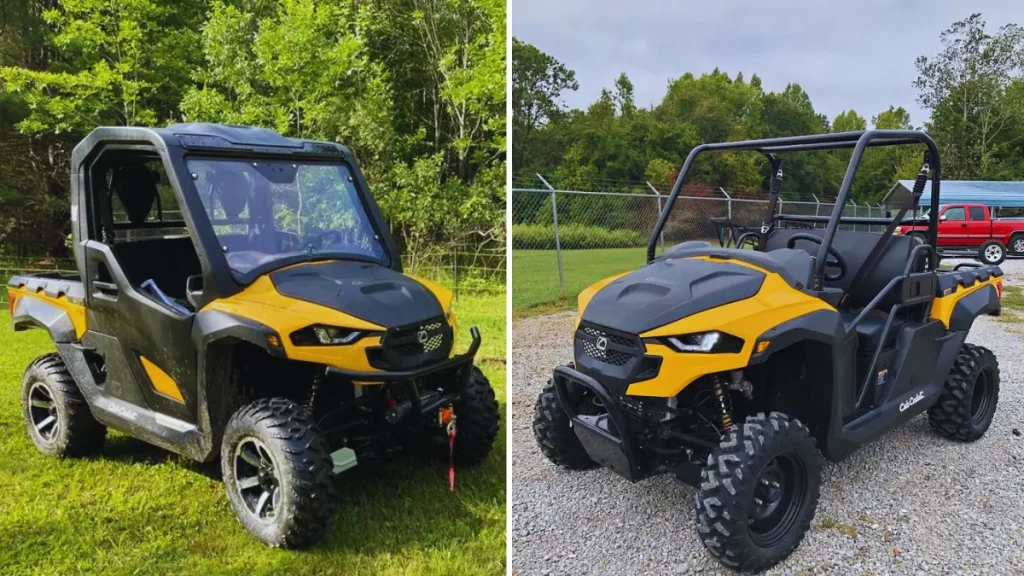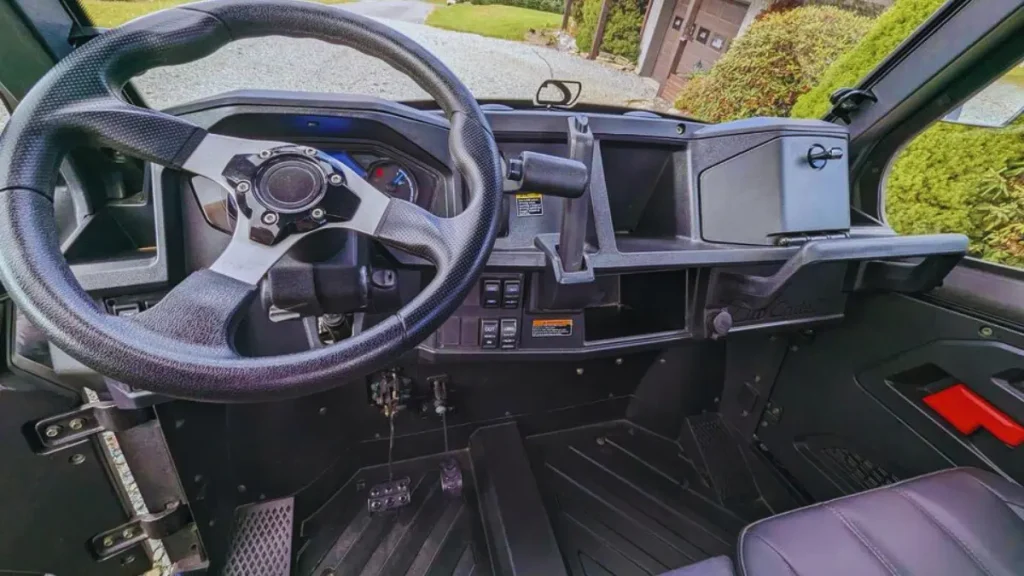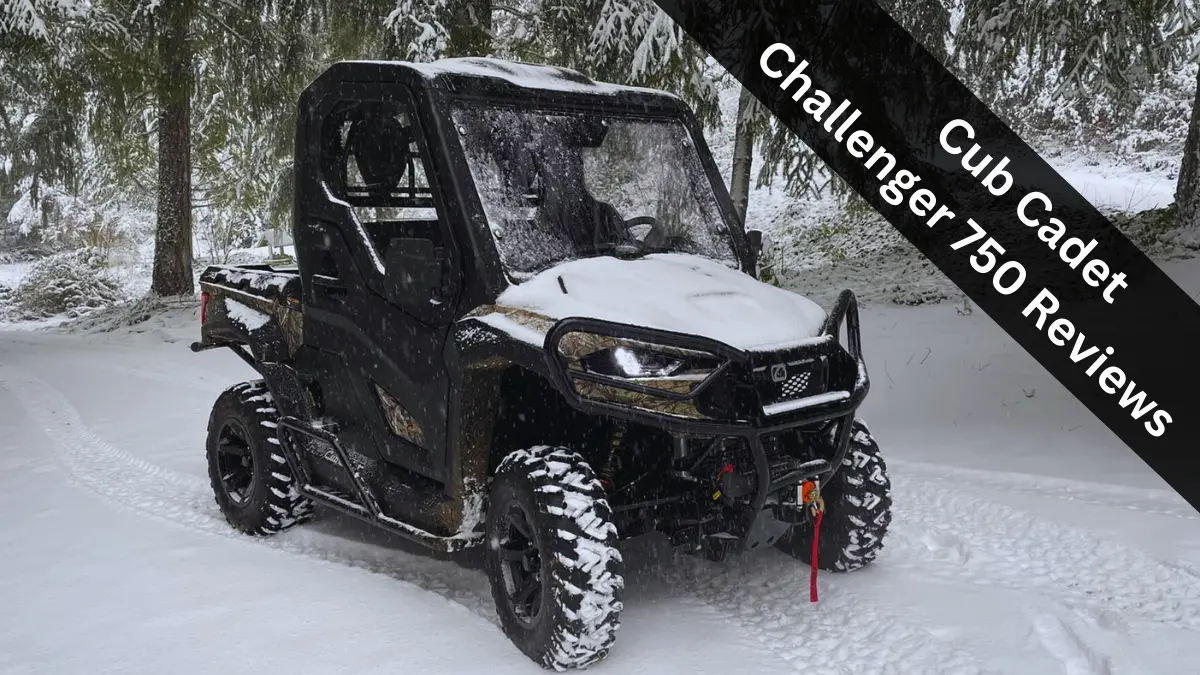If you’re considering pulling the trigger on one of the striking Challenger 750 utility-side by-sides from Cub Cadet, there are definitely a few things you’ll want to consider before doing so.
Cub Cadet has made some pretty big changes to their UTVs in recent years, which has resulted in some of them being higher-quality than others.
We’ll tell you which years are the most reliable in this review of the Challenger 750, along with detailing the following:
- Build quality and performance
- Design and durability
- Key features and accessories
- How fast these models go
- What current owners like
- What current owners dislike
About The Cub Cadet Challenger 750 Models
The Challenger 750 models are Cub Cadet’s biggest and most powerful utility side-by-side options.
Their quality has greatly improved in the last few years, though they still don’t quite compare to some of the best UTV values in the industry.
There are two separate models to choose from in 2024:
- Challenger M 750 ($13,499 MSRP)
- Challenger MX 750 ($16,499 MSRP)
These two models really only differ in the accessory package they come equipped with, which will be detailed further along in this guide.
But in short, the MX 750 comes loaded with many more accessories than the M 750, making it much more off-road capable right out of the box.
But the difference in price reflects that, as you can see.
Additionally, the Challenger M 750 comes in two different color options while the MX 750 is available in three.

Build Quality & Performance
Engine
The Challenger 750 comes equipped with a 735cc single-cylinder engine made by Hisun Motors in China, the same engine used in the Hisun Sector 750.
They get a maximum engine output of around 38 horsepower.
These Hisun engines have improved over the years, but do still have some weak points including the timing chains which are known to give out prematurely.
The engine power of 38 horsepower is plenty sufficient for most work tasks and trail riding, but there is a noticeable lack of get-up upon initial acceleration.
Once this vehicle gets going though, the power is good throughout the RPM ranges.
The engines are also noticeably loud, especially in the cab area while riding.
But the engine compartment is just under the passenger seat and is easy to access by removing a plastic cover, making maintenance pretty simple.
| Engine Type | Four Stroke, SOHC |
| Cylinder Arrangement | Single-Cylinder |
| Displacement | 735 cc |
| Horsepower | 38 HP |
| Fuel System | EFI |
| Engine Cooling | Liquid Cooling |
| Fuel Capacity | 7.4 Gallons |
Drivetrain
Mated to the engines in these vehicles is an automatic CVT-style transmission which makes for smooth shifts.
You have the option of both 2WD and 4WD, which you can select via a switch on the dash. A big plus is the locking rear differential that provides extra traction when needed.
When you throw this model into 4WD and lock the differential, there’s not much that it won’t climb or crawl which makes it great on tough trails and in harsh terrain.
The gear shift sits on the dash, and offers you a Park, Reverse, and Neutral setting along with both High and Low gears.
The wet clutch in these models was upgraded to a bigger, more heavy-duty unit in 2019+ models, which was severely needed as they seemed to go out consistently on pre-2019 Challengers.
As long as you use a wet-clutch friendly oil and drive in the correct gear, you shouldn’t have many problems on newer units.
| Drive System | Selectable 2WD/4WD w/ Rear Diff Lock |
| Transmission Type | Automatic CVT |
| Gear Shift Pattern | P – R – N – H – L |
Suspension
The suspension system is sold in these machines, with independent dual A-Arms in the front and rear. You get 9 inches of travel up front and 8 inches in the rear.
The shocks have three adjustment points where you can adjust the rebound, preload spring and damping rate so that you can find the best fit for your riding style.
The ground clearance is as solid as it gets for a utility side-by-side, at just under 12 inches.
This adds to Challenger’s trail riding ability, helping you to clear most obstacles in the trail and avoid getting stuck on most ruts.
| Turning Radius | 28 ft |
| Wheelbase | 76.7 in |
| Ground Clearance | 11.6 in |
| Front Suspension | Independent Dual A-Arm |
| Rear Suspension | Independent Dual A-Arm |
| Front Travel | 9 in |
| Rear Travel | 8 in |
Tires & Brakes
The stock tires are off-road knobby tires that offer plenty of traction and do well in just about any terrain.
They’re 26-inches in diameter all the way around, along with steel wheels on the M models and alloy wheels on the MX models.
The disc brakes at all four wheels provide good stopping power for this model in any terrain or on any surface.
There’s also a dash-mounted parking brake to the right of the gear shift, which is recommended to use over the Park setting when on an incline to avoid wearing down the transmission.
| Front Tires | 26 x 9-14 |
| Rear Tires | 26 x 9-14 |
| Wheels | Steel |
| Front Brake Type | Wet Disc |
| Rear Brake Type | Wet Disc |
Dimensions & Capacities
The Challenger 750 is about average in terms of its overall size, at 118 inches in length, 62 inches wide, and 77 inches tall.
It’s not compact enough to make it good in tight wooded areas or tight trails, but it’s also not so big that it’s severely restricted to where it can go.
The turning radius more than makes up for this though, with one of the tightest turning radiuses in the industry enabling it to snake around sharp turns with ease.
It offers a good-sized rear cargo bed with a hauling capacity of 500 lbs, and it can tow up to 1,200 lbs making it a solid working vehicle.
| Length | 118 in |
| Width | 62 in |
| Height | 77 in |
| Dry Weight | 1,456 lbs |
| Towing Capacity | 1,200 lbs |
| Cargo Box Capacity | 500 lbs |
Key Features & Accessories
The Cub Cadet Challenger M 750 comes with some standard accessories, including power steering, steel tube side doors, a digital display, bumper guard, LED headlights and brake lights, and turn signals.
If you want a fully loaded model, the Challenger MX 750 comes flush with accessories, including:
- Power steering
- Hard-top roof
- 3/4 side doors with vents
- LED high/low beam headlights
- Brake lights
- Tail lights
- Hazard flasher lights
- Front winch
- Leather, contoured seats
- Side mirrors
- Passenger side grab bar in cab
Both models have a good-sized dump bed in the rear, with gas-assisted strut for easy lifting.
The dump bed liner is a big plus as it’s reinforced steel and holds up well to working unlike so many other models’ flimsy plastic dump beds.
And both come with a two-inch hitch receiver in the rear for towing, along with a receiver up front where you can install a plow or other farm equipment.
Cub Cadet Challenger 750 Top Speed
The Cub Cadet Challenger M and MX 750 models are both built to be working machines.
But they offer plenty of recreational appeal, making for solid trail riding options.
They won’t keep up with the fastest utility side-by-sides in the industry when it comes to top-end speed, but they can go a respectable 50 mph when you feel like opening it up.
What Owners Like
- The locking differential gives these models excellent added traction for trail riding.
- The turning radius on these machines is awesome, enabling very tight turns.
- The electrical connections and stock wiring harness was upgraded as of 2020, making for less issues.
- All models come standard with power steering.
- Tons of storage space with multiple deep compartments on the dash, a good-size glove box, and storage under the front hood.
- The cab is plenty spacious, offering good leg-room and space between two riders of any size.
- The dump bed opens easily with gas-assisted shock.
- Tailgate is quite strong, so that you can easily sit or stand on it while it’s open.
- Dump bed liner is reinforced steel and holds up very well to abuse.
- These models get good fuel economy compared to competition.
- MX models come flush with accessories that make them off-road ready from the jump.

What Owners Dislike
- These models feel a bit top-heavy when driving, though they don’t end up being tippy.
- The single-cylinder engine makes the cab area extremely loud.
- The windshield that you can purchase as an accessory is easily scratched, so you’re better off going with an aftermarket unit.
- These models are known to have clutch issues, especially those made prior to 2019.
- The gear shift will sometimes stick in these models, and the added force needed to move them has resulted in gear shifts snapping for some.
- The recommended oil level for these models is known to be too low which will lead to issues with the wet clutch, so you should be adding an extra quart or so over the “capacity” each time you refill.
- The dump bed has a feature that helps it to stay upright, which also makes it pretty hard to close when you want to.
- It can be hard to find mechanics to work on these machines.
- Cub Cadet customer service can be lacking and the warranty process can be frustrating and long.
You can read more detail on some of these drawbacks in this guide to the Challenger 750’s most common problems.
Which Years To Avoid
If you’re considering a brand new Challenger 750, most models turn out to be solid vehicles with the upgrades to some of the previously problematic parts and components in 2019.
But based upon issues surfaced by current owners, 2016-2018 Challenger 750’s should give you the willies and may be best to avoid.
This goes for the Cub Cadet Challenger 550 models as well.


